Strategic Marketing Decisions: Big Data Analytics' Role and Impact
VerifiedAdded on 2021/05/27
|6
|2221
|84
Report
AI Summary
This report investigates the impact of big data analytics on strategic marketing decisions. It explores the evolution from traditional marketing to modern big data approaches, emphasizing the challenges and characteristics of big data, including volume, variety, velocity, variability, and value. The research addresses key questions regarding how big data analytics improves strategic marketing decisions, the cost-effectiveness of big data analytics compared to traditional methods, and the accuracy of information provided. The methodology involves interpretivism, case studies, and literature reviews to assess the value of big data analytics in enhancing decision-making processes, improving data accuracy, and providing businesses with a competitive edge. The report offers insights into data collection, analysis techniques, and the implications of big data analytics for marketing strategies. It also highlights the importance of accurate data for strategic decisions and identifies the efficiency levels of different approaches and technologies.
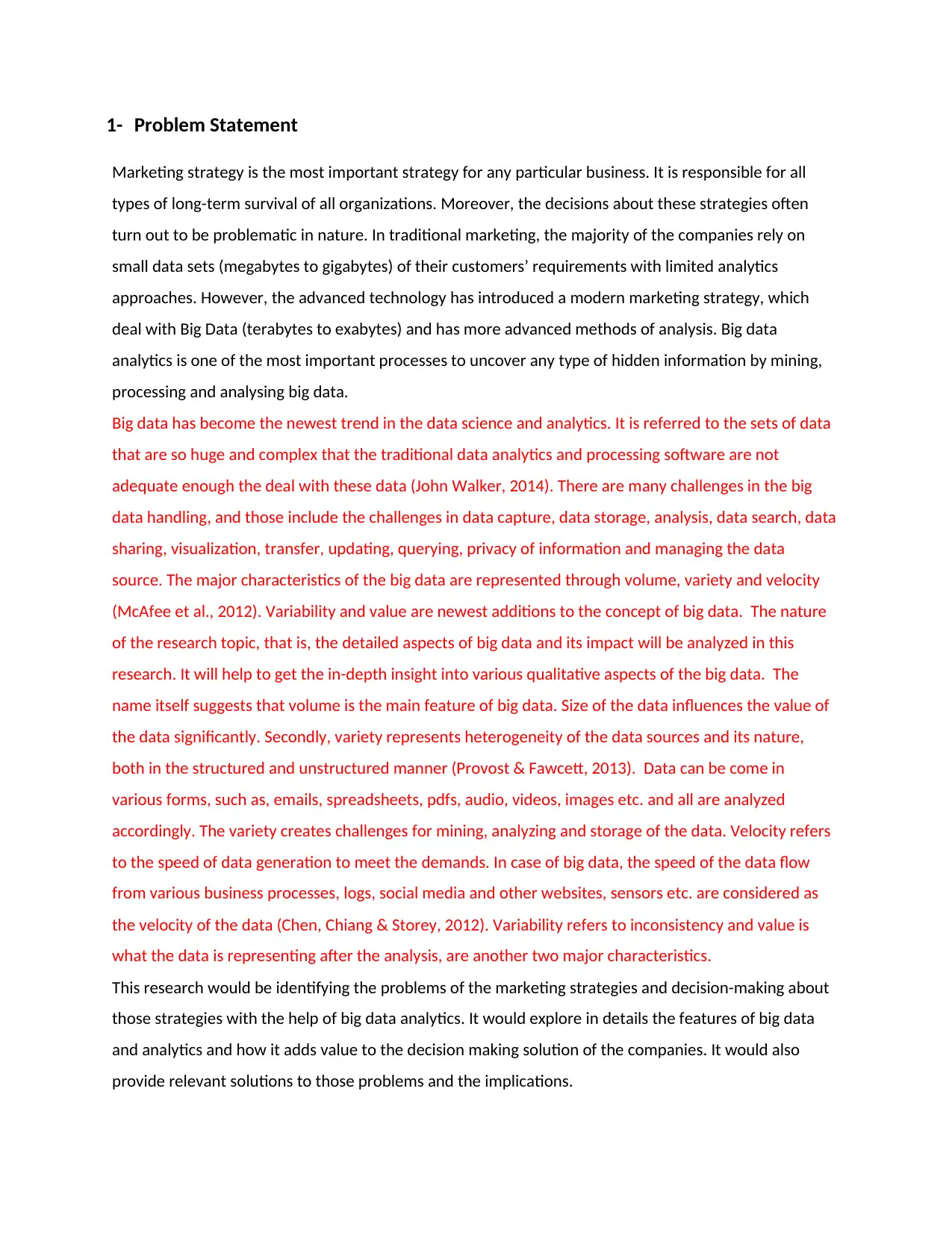
1- Problem Statement
Marketing strategy is the most important strategy for any particular business. It is responsible for all
types of long-term survival of all organizations. Moreover, the decisions about these strategies often
turn out to be problematic in nature. In traditional marketing, the majority of the companies rely on
small data sets (megabytes to gigabytes) of their customers’ requirements with limited analytics
approaches. However, the advanced technology has introduced a modern marketing strategy, which
deal with Big Data (terabytes to exabytes) and has more advanced methods of analysis. Big data
analytics is one of the most important processes to uncover any type of hidden information by mining,
processing and analysing big data.
Big data has become the newest trend in the data science and analytics. It is referred to the sets of data
that are so huge and complex that the traditional data analytics and processing software are not
adequate enough the deal with these data (John Walker, 2014). There are many challenges in the big
data handling, and those include the challenges in data capture, data storage, analysis, data search, data
sharing, visualization, transfer, updating, querying, privacy of information and managing the data
source. The major characteristics of the big data are represented through volume, variety and velocity
(McAfee et al., 2012). Variability and value are newest additions to the concept of big data. The nature
of the research topic, that is, the detailed aspects of big data and its impact will be analyzed in this
research. It will help to get the in-depth insight into various qualitative aspects of the big data. The
name itself suggests that volume is the main feature of big data. Size of the data influences the value of
the data significantly. Secondly, variety represents heterogeneity of the data sources and its nature,
both in the structured and unstructured manner (Provost & Fawcett, 2013). Data can be come in
various forms, such as, emails, spreadsheets, pdfs, audio, videos, images etc. and all are analyzed
accordingly. The variety creates challenges for mining, analyzing and storage of the data. Velocity refers
to the speed of data generation to meet the demands. In case of big data, the speed of the data flow
from various business processes, logs, social media and other websites, sensors etc. are considered as
the velocity of the data (Chen, Chiang & Storey, 2012). Variability refers to inconsistency and value is
what the data is representing after the analysis, are another two major characteristics.
This research would be identifying the problems of the marketing strategies and decision-making about
those strategies with the help of big data analytics. It would explore in details the features of big data
and analytics and how it adds value to the decision making solution of the companies. It would also
provide relevant solutions to those problems and the implications.
Marketing strategy is the most important strategy for any particular business. It is responsible for all
types of long-term survival of all organizations. Moreover, the decisions about these strategies often
turn out to be problematic in nature. In traditional marketing, the majority of the companies rely on
small data sets (megabytes to gigabytes) of their customers’ requirements with limited analytics
approaches. However, the advanced technology has introduced a modern marketing strategy, which
deal with Big Data (terabytes to exabytes) and has more advanced methods of analysis. Big data
analytics is one of the most important processes to uncover any type of hidden information by mining,
processing and analysing big data.
Big data has become the newest trend in the data science and analytics. It is referred to the sets of data
that are so huge and complex that the traditional data analytics and processing software are not
adequate enough the deal with these data (John Walker, 2014). There are many challenges in the big
data handling, and those include the challenges in data capture, data storage, analysis, data search, data
sharing, visualization, transfer, updating, querying, privacy of information and managing the data
source. The major characteristics of the big data are represented through volume, variety and velocity
(McAfee et al., 2012). Variability and value are newest additions to the concept of big data. The nature
of the research topic, that is, the detailed aspects of big data and its impact will be analyzed in this
research. It will help to get the in-depth insight into various qualitative aspects of the big data. The
name itself suggests that volume is the main feature of big data. Size of the data influences the value of
the data significantly. Secondly, variety represents heterogeneity of the data sources and its nature,
both in the structured and unstructured manner (Provost & Fawcett, 2013). Data can be come in
various forms, such as, emails, spreadsheets, pdfs, audio, videos, images etc. and all are analyzed
accordingly. The variety creates challenges for mining, analyzing and storage of the data. Velocity refers
to the speed of data generation to meet the demands. In case of big data, the speed of the data flow
from various business processes, logs, social media and other websites, sensors etc. are considered as
the velocity of the data (Chen, Chiang & Storey, 2012). Variability refers to inconsistency and value is
what the data is representing after the analysis, are another two major characteristics.
This research would be identifying the problems of the marketing strategies and decision-making about
those strategies with the help of big data analytics. It would explore in details the features of big data
and analytics and how it adds value to the decision making solution of the companies. It would also
provide relevant solutions to those problems and the implications.
Paraphrase This Document
Need a fresh take? Get an instant paraphrase of this document with our AI Paraphraser
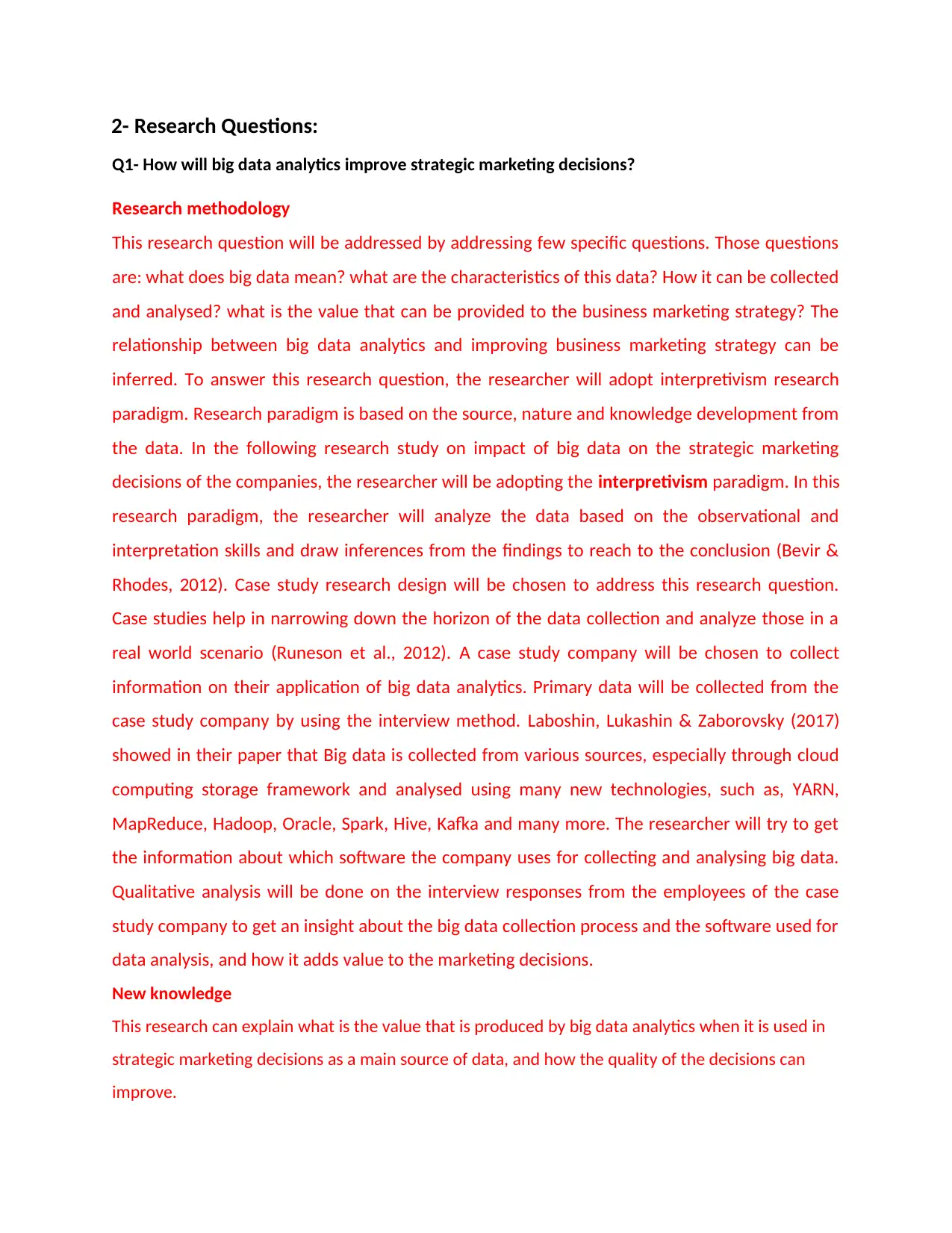
2- Research Questions:
Q1- How will big data analytics improve strategic marketing decisions?
Research methodology
This research question will be addressed by addressing few specific questions. Those questions
are: what does big data mean? what are the characteristics of this data? How it can be collected
and analysed? what is the value that can be provided to the business marketing strategy? The
relationship between big data analytics and improving business marketing strategy can be
inferred. To answer this research question, the researcher will adopt interpretivism research
paradigm. Research paradigm is based on the source, nature and knowledge development from
the data. In the following research study on impact of big data on the strategic marketing
decisions of the companies, the researcher will be adopting the interpretivism paradigm. In this
research paradigm, the researcher will analyze the data based on the observational and
interpretation skills and draw inferences from the findings to reach to the conclusion (Bevir &
Rhodes, 2012). Case study research design will be chosen to address this research question.
Case studies help in narrowing down the horizon of the data collection and analyze those in a
real world scenario (Runeson et al., 2012). A case study company will be chosen to collect
information on their application of big data analytics. Primary data will be collected from the
case study company by using the interview method. Laboshin, Lukashin & Zaborovsky (2017)
showed in their paper that Big data is collected from various sources, especially through cloud
computing storage framework and analysed using many new technologies, such as, YARN,
MapReduce, Hadoop, Oracle, Spark, Hive, Kafka and many more. The researcher will try to get
the information about which software the company uses for collecting and analysing big data.
Qualitative analysis will be done on the interview responses from the employees of the case
study company to get an insight about the big data collection process and the software used for
data analysis, and how it adds value to the marketing decisions.
New knowledge
This research can explain what is the value that is produced by big data analytics when it is used in
strategic marketing decisions as a main source of data, and how the quality of the decisions can
improve.
Q1- How will big data analytics improve strategic marketing decisions?
Research methodology
This research question will be addressed by addressing few specific questions. Those questions
are: what does big data mean? what are the characteristics of this data? How it can be collected
and analysed? what is the value that can be provided to the business marketing strategy? The
relationship between big data analytics and improving business marketing strategy can be
inferred. To answer this research question, the researcher will adopt interpretivism research
paradigm. Research paradigm is based on the source, nature and knowledge development from
the data. In the following research study on impact of big data on the strategic marketing
decisions of the companies, the researcher will be adopting the interpretivism paradigm. In this
research paradigm, the researcher will analyze the data based on the observational and
interpretation skills and draw inferences from the findings to reach to the conclusion (Bevir &
Rhodes, 2012). Case study research design will be chosen to address this research question.
Case studies help in narrowing down the horizon of the data collection and analyze those in a
real world scenario (Runeson et al., 2012). A case study company will be chosen to collect
information on their application of big data analytics. Primary data will be collected from the
case study company by using the interview method. Laboshin, Lukashin & Zaborovsky (2017)
showed in their paper that Big data is collected from various sources, especially through cloud
computing storage framework and analysed using many new technologies, such as, YARN,
MapReduce, Hadoop, Oracle, Spark, Hive, Kafka and many more. The researcher will try to get
the information about which software the company uses for collecting and analysing big data.
Qualitative analysis will be done on the interview responses from the employees of the case
study company to get an insight about the big data collection process and the software used for
data analysis, and how it adds value to the marketing decisions.
New knowledge
This research can explain what is the value that is produced by big data analytics when it is used in
strategic marketing decisions as a main source of data, and how the quality of the decisions can
improve.
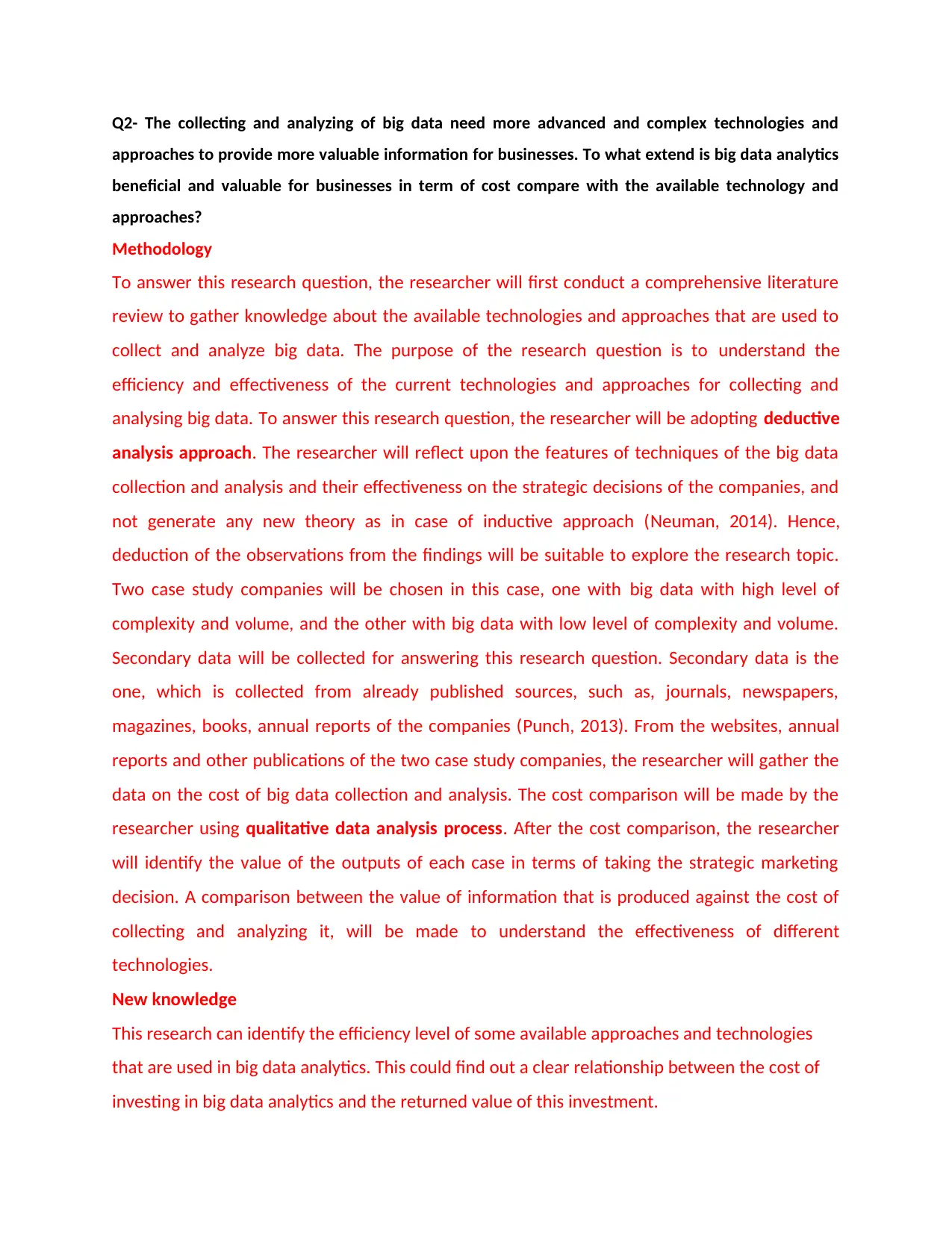
Q2- The collecting and analyzing of big data need more advanced and complex technologies and
approaches to provide more valuable information for businesses. To what extend is big data analytics
beneficial and valuable for businesses in term of cost compare with the available technology and
approaches?
Methodology
To answer this research question, the researcher will first conduct a comprehensive literature
review to gather knowledge about the available technologies and approaches that are used to
collect and analyze big data. The purpose of the research question is to understand the
efficiency and effectiveness of the current technologies and approaches for collecting and
analysing big data. To answer this research question, the researcher will be adopting deductive
analysis approach. The researcher will reflect upon the features of techniques of the big data
collection and analysis and their effectiveness on the strategic decisions of the companies, and
not generate any new theory as in case of inductive approach (Neuman, 2014). Hence,
deduction of the observations from the findings will be suitable to explore the research topic.
Two case study companies will be chosen in this case, one with big data with high level of
complexity and volume, and the other with big data with low level of complexity and volume.
Secondary data will be collected for answering this research question. Secondary data is the
one, which is collected from already published sources, such as, journals, newspapers,
magazines, books, annual reports of the companies (Punch, 2013). From the websites, annual
reports and other publications of the two case study companies, the researcher will gather the
data on the cost of big data collection and analysis. The cost comparison will be made by the
researcher using qualitative data analysis process. After the cost comparison, the researcher
will identify the value of the outputs of each case in terms of taking the strategic marketing
decision. A comparison between the value of information that is produced against the cost of
collecting and analyzing it, will be made to understand the effectiveness of different
technologies.
New knowledge
This research can identify the efficiency level of some available approaches and technologies
that are used in big data analytics. This could find out a clear relationship between the cost of
investing in big data analytics and the returned value of this investment.
approaches to provide more valuable information for businesses. To what extend is big data analytics
beneficial and valuable for businesses in term of cost compare with the available technology and
approaches?
Methodology
To answer this research question, the researcher will first conduct a comprehensive literature
review to gather knowledge about the available technologies and approaches that are used to
collect and analyze big data. The purpose of the research question is to understand the
efficiency and effectiveness of the current technologies and approaches for collecting and
analysing big data. To answer this research question, the researcher will be adopting deductive
analysis approach. The researcher will reflect upon the features of techniques of the big data
collection and analysis and their effectiveness on the strategic decisions of the companies, and
not generate any new theory as in case of inductive approach (Neuman, 2014). Hence,
deduction of the observations from the findings will be suitable to explore the research topic.
Two case study companies will be chosen in this case, one with big data with high level of
complexity and volume, and the other with big data with low level of complexity and volume.
Secondary data will be collected for answering this research question. Secondary data is the
one, which is collected from already published sources, such as, journals, newspapers,
magazines, books, annual reports of the companies (Punch, 2013). From the websites, annual
reports and other publications of the two case study companies, the researcher will gather the
data on the cost of big data collection and analysis. The cost comparison will be made by the
researcher using qualitative data analysis process. After the cost comparison, the researcher
will identify the value of the outputs of each case in terms of taking the strategic marketing
decision. A comparison between the value of information that is produced against the cost of
collecting and analyzing it, will be made to understand the effectiveness of different
technologies.
New knowledge
This research can identify the efficiency level of some available approaches and technologies
that are used in big data analytics. This could find out a clear relationship between the cost of
investing in big data analytics and the returned value of this investment.
⊘ This is a preview!⊘
Do you want full access?
Subscribe today to unlock all pages.

Trusted by 1+ million students worldwide
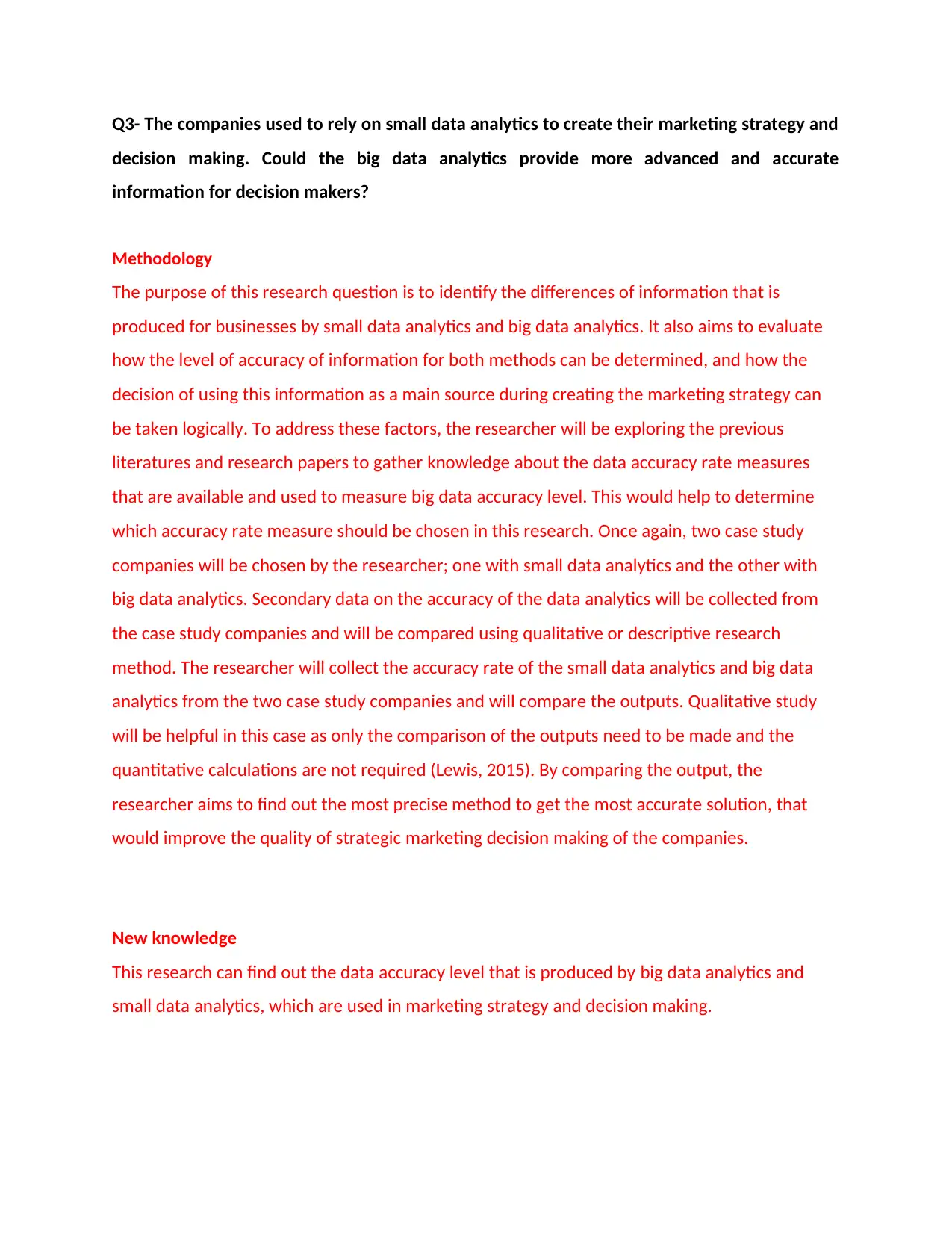
Q3- The companies used to rely on small data analytics to create their marketing strategy and
decision making. Could the big data analytics provide more advanced and accurate
information for decision makers?
Methodology
The purpose of this research question is to identify the differences of information that is
produced for businesses by small data analytics and big data analytics. It also aims to evaluate
how the level of accuracy of information for both methods can be determined, and how the
decision of using this information as a main source during creating the marketing strategy can
be taken logically. To address these factors, the researcher will be exploring the previous
literatures and research papers to gather knowledge about the data accuracy rate measures
that are available and used to measure big data accuracy level. This would help to determine
which accuracy rate measure should be chosen in this research. Once again, two case study
companies will be chosen by the researcher; one with small data analytics and the other with
big data analytics. Secondary data on the accuracy of the data analytics will be collected from
the case study companies and will be compared using qualitative or descriptive research
method. The researcher will collect the accuracy rate of the small data analytics and big data
analytics from the two case study companies and will compare the outputs. Qualitative study
will be helpful in this case as only the comparison of the outputs need to be made and the
quantitative calculations are not required (Lewis, 2015). By comparing the output, the
researcher aims to find out the most precise method to get the most accurate solution, that
would improve the quality of strategic marketing decision making of the companies.
New knowledge
This research can find out the data accuracy level that is produced by big data analytics and
small data analytics, which are used in marketing strategy and decision making.
decision making. Could the big data analytics provide more advanced and accurate
information for decision makers?
Methodology
The purpose of this research question is to identify the differences of information that is
produced for businesses by small data analytics and big data analytics. It also aims to evaluate
how the level of accuracy of information for both methods can be determined, and how the
decision of using this information as a main source during creating the marketing strategy can
be taken logically. To address these factors, the researcher will be exploring the previous
literatures and research papers to gather knowledge about the data accuracy rate measures
that are available and used to measure big data accuracy level. This would help to determine
which accuracy rate measure should be chosen in this research. Once again, two case study
companies will be chosen by the researcher; one with small data analytics and the other with
big data analytics. Secondary data on the accuracy of the data analytics will be collected from
the case study companies and will be compared using qualitative or descriptive research
method. The researcher will collect the accuracy rate of the small data analytics and big data
analytics from the two case study companies and will compare the outputs. Qualitative study
will be helpful in this case as only the comparison of the outputs need to be made and the
quantitative calculations are not required (Lewis, 2015). By comparing the output, the
researcher aims to find out the most precise method to get the most accurate solution, that
would improve the quality of strategic marketing decision making of the companies.
New knowledge
This research can find out the data accuracy level that is produced by big data analytics and
small data analytics, which are used in marketing strategy and decision making.
Paraphrase This Document
Need a fresh take? Get an instant paraphrase of this document with our AI Paraphraser
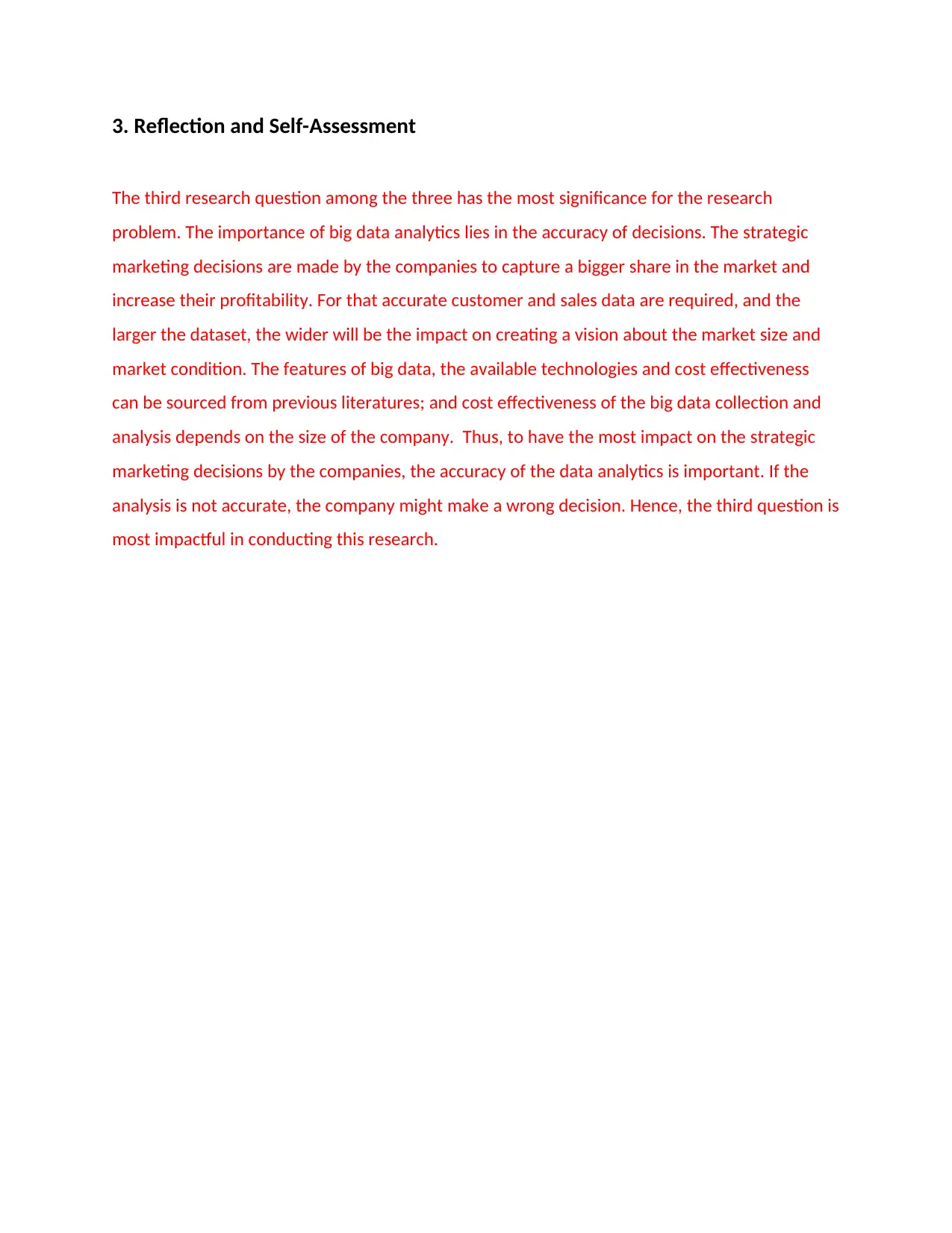
3. Reflection and Self-Assessment
The third research question among the three has the most significance for the research
problem. The importance of big data analytics lies in the accuracy of decisions. The strategic
marketing decisions are made by the companies to capture a bigger share in the market and
increase their profitability. For that accurate customer and sales data are required, and the
larger the dataset, the wider will be the impact on creating a vision about the market size and
market condition. The features of big data, the available technologies and cost effectiveness
can be sourced from previous literatures; and cost effectiveness of the big data collection and
analysis depends on the size of the company. Thus, to have the most impact on the strategic
marketing decisions by the companies, the accuracy of the data analytics is important. If the
analysis is not accurate, the company might make a wrong decision. Hence, the third question is
most impactful in conducting this research.
The third research question among the three has the most significance for the research
problem. The importance of big data analytics lies in the accuracy of decisions. The strategic
marketing decisions are made by the companies to capture a bigger share in the market and
increase their profitability. For that accurate customer and sales data are required, and the
larger the dataset, the wider will be the impact on creating a vision about the market size and
market condition. The features of big data, the available technologies and cost effectiveness
can be sourced from previous literatures; and cost effectiveness of the big data collection and
analysis depends on the size of the company. Thus, to have the most impact on the strategic
marketing decisions by the companies, the accuracy of the data analytics is important. If the
analysis is not accurate, the company might make a wrong decision. Hence, the third question is
most impactful in conducting this research.
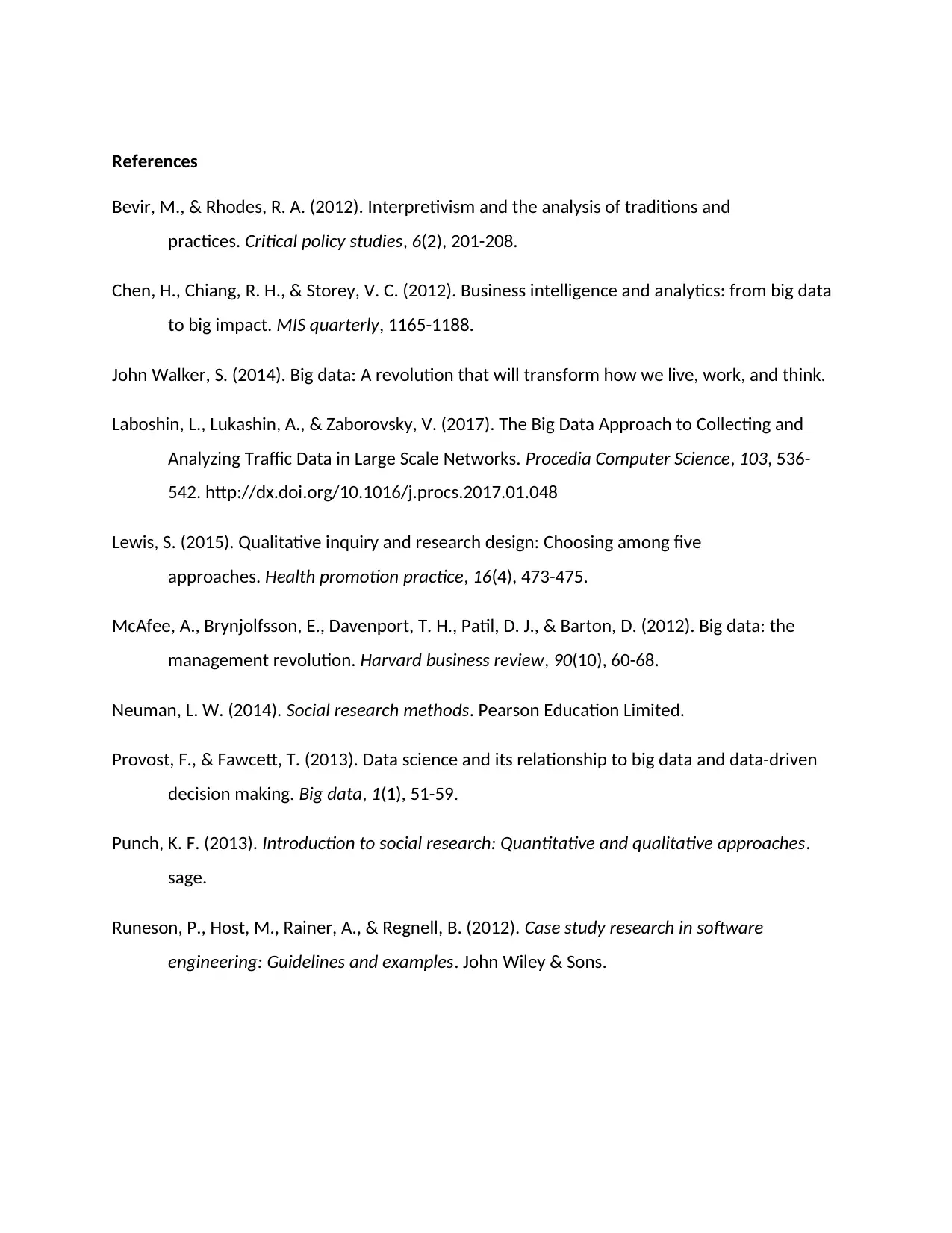
References
Bevir, M., & Rhodes, R. A. (2012). Interpretivism and the analysis of traditions and
practices. Critical policy studies, 6(2), 201-208.
Chen, H., Chiang, R. H., & Storey, V. C. (2012). Business intelligence and analytics: from big data
to big impact. MIS quarterly, 1165-1188.
John Walker, S. (2014). Big data: A revolution that will transform how we live, work, and think.
Laboshin, L., Lukashin, A., & Zaborovsky, V. (2017). The Big Data Approach to Collecting and
Analyzing Traffic Data in Large Scale Networks. Procedia Computer Science, 103, 536-
542. http://dx.doi.org/10.1016/j.procs.2017.01.048
Lewis, S. (2015). Qualitative inquiry and research design: Choosing among five
approaches. Health promotion practice, 16(4), 473-475.
McAfee, A., Brynjolfsson, E., Davenport, T. H., Patil, D. J., & Barton, D. (2012). Big data: the
management revolution. Harvard business review, 90(10), 60-68.
Neuman, L. W. (2014). Social research methods. Pearson Education Limited.
Provost, F., & Fawcett, T. (2013). Data science and its relationship to big data and data-driven
decision making. Big data, 1(1), 51-59.
Punch, K. F. (2013). Introduction to social research: Quantitative and qualitative approaches.
sage.
Runeson, P., Host, M., Rainer, A., & Regnell, B. (2012). Case study research in software
engineering: Guidelines and examples. John Wiley & Sons.
Bevir, M., & Rhodes, R. A. (2012). Interpretivism and the analysis of traditions and
practices. Critical policy studies, 6(2), 201-208.
Chen, H., Chiang, R. H., & Storey, V. C. (2012). Business intelligence and analytics: from big data
to big impact. MIS quarterly, 1165-1188.
John Walker, S. (2014). Big data: A revolution that will transform how we live, work, and think.
Laboshin, L., Lukashin, A., & Zaborovsky, V. (2017). The Big Data Approach to Collecting and
Analyzing Traffic Data in Large Scale Networks. Procedia Computer Science, 103, 536-
542. http://dx.doi.org/10.1016/j.procs.2017.01.048
Lewis, S. (2015). Qualitative inquiry and research design: Choosing among five
approaches. Health promotion practice, 16(4), 473-475.
McAfee, A., Brynjolfsson, E., Davenport, T. H., Patil, D. J., & Barton, D. (2012). Big data: the
management revolution. Harvard business review, 90(10), 60-68.
Neuman, L. W. (2014). Social research methods. Pearson Education Limited.
Provost, F., & Fawcett, T. (2013). Data science and its relationship to big data and data-driven
decision making. Big data, 1(1), 51-59.
Punch, K. F. (2013). Introduction to social research: Quantitative and qualitative approaches.
sage.
Runeson, P., Host, M., Rainer, A., & Regnell, B. (2012). Case study research in software
engineering: Guidelines and examples. John Wiley & Sons.
⊘ This is a preview!⊘
Do you want full access?
Subscribe today to unlock all pages.

Trusted by 1+ million students worldwide
1 out of 6
Related Documents
Your All-in-One AI-Powered Toolkit for Academic Success.
+13062052269
info@desklib.com
Available 24*7 on WhatsApp / Email
![[object Object]](/_next/static/media/star-bottom.7253800d.svg)
Unlock your academic potential
Copyright © 2020–2025 A2Z Services. All Rights Reserved. Developed and managed by ZUCOL.


